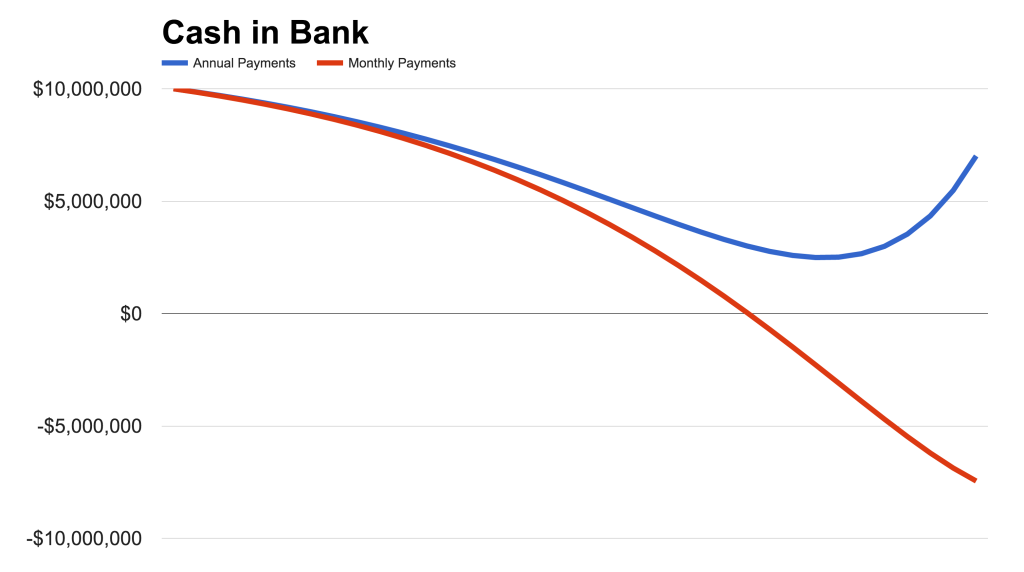There has been an incredible amount of chatter about the coming downturn. Public tech stocks are down, but people are confused about how this might affect earlier stages.
You don’t want to over react and miss the opportunity in front of you. But founders tend to be hopeless optimists and bias towards driving off a cliff with their foot slammed on the gas.
So it’s time to consider roach mode: do whatever you need to do to survive, like a cockroach.
Study History
I feel old saying this, but some founders don’t remember 2008. There was a financial crisis that caused the funding environment to change very quickly.
Sequoia Capital went into freak-out mode and sent their portfolio a presentation called “RIP Good Times”. You should go and read the whole thing here. The advice is rock solid: cut burn now in order to save the company later.
More recently, Paul Graham wrote an excellent essay: Default Alive or Default Dead?
First Round describes the Watney Rule: “We need to act like we’re Mark Watney in the Martian. We can’t assume we will get a shipment of new potatoes to save us.”
“Roach mode” rhymes, so it might be easier for founders to remember. ?
Investor Relations
If you’ve raised money, talk with your investors. Mine have been proactive about explaining how they think the environment is evolving. Hard times are a test for the quality of investors. The best investors are honest and transparent, making them predictable even in hard times.
I love our investors, and they’ve expressed strong support for us. But I’m going to act like that isn’t true. Roach mode means acting like there isn’t more money coming.
Another version of this is taking a lower valuation than you expected. If you shut down your company because of some valuation pissing match, you’re an idiot.
Revenue Structure
There has been a major problem brewing in SAAS businesses: they can predictably grow revenue, but normal accounting makes it look like they lose money. Spend $1K in ads and sales team comp, in 12 months you get back that $1K, and in another 12 you make another $1K. This sounds like a deal until you realize this depends upon external funding to push growth through the short term trough of losses.
Some SAAS companies see this pattern and push to be paid early. For example, eShares just changed to annual billing. This means you pay upfront for a year so that the company doesn’t go into the hole at all. The problem with this approach is that it doesn’t match up with customer value. Any decision that is good for your business but bad for customers should be suspect. But in roach mode, every option is on the table.
Check out this excellent post about strategic finance for more.
New Revenue Channels
YesGraph recently launched an awesome class around growth, where we help you build an experimental process, understand your analytics, understand virality, hire for growth, and more. It is not free, but compared to the value it’s cheap at $199. Check it out here: http://learn.yesgraph.com/
Why are we doing this? One of the reasons is that it’s a lead gen source for us — a premium content marketing play. But there are other structural issues. If we can run ads to get people to pay for the class, then the paid acquisition strategy isn’t the same as the problem in SAAS with marketing and sales costing too much up from. We can efficiently run ads to buy the class, which then pays off immediately.
Plus the ad campaigns we run are going to be open to people that take the class so we can demonstrate what paid acquisition looks like. That’s delightfully meta.
We’re trading more leads with high quality leads (you’re willing to pay for growth), and biasing towards immediate revenue.
We just launched another similar effort: growth teardowns. We just reviewed Telegram Messenger, and are queueing up more. These aren’t free: we’re essentially scaling consulting work in a way that strongly aligns with the service that we build. We’ve been helping YesGraph’s customers with growth advice already, so this fit our mission of helping companies grow faster.
Similar to the growth class, we can run ads to the teardowns to get more clients. It’s transactional and more efficient than other kinds of lead gen. If you want to better understand your growth, email teardown@yesgraph.com
Cutting Payroll
Besides expensive paid acquisition, another major expense for many companies is payroll. Good engineers are expensive, so one of the simplest ways to live longer is to cut payroll.
This is brutally hard at times, but that’s roach mode. Take this slide from RIP Good Times.
If you cut early, you’ll have the extended runway to live forever. If you don’t, you’ll fall off a cliff.
But use your judgement here. YesGraph has recently hired some excellent engineers. I don’t think we have too many. I think we have enough to take on the opportunity, and we’d be strained to make progress with fewer people. We’re already lean because I started out sensitive to over hiring, even without a downturn coming.
Your Strategy
I might be doing something obviously wrong. Some people think offices are expensive, but our office is less than 3% of our expenses. We still buy food, but that’s less than 1% of our expenses.
One reason I wrote this is to hear what I might be missing. So tell me in the comments or email me: ivan@yesgraph.com



